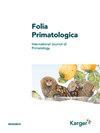马达加斯加北部Montagne des Français干燥森林中的Lepilemur septentrisis的觅食生态学
IF 0.8
4区 生物学
Q2 ZOOLOGY
引用次数: 0
摘要
叶性灵长类动物在生态系统恢复中的作用在很大程度上被忽视了。这可能主要是由于缺乏这些物种的基本生态信息。例如,北方运动狐猴是世界上最濒危的灵长类动物之一,但我们缺乏对这种狐猴的基本生态学知识。这种缺乏只会加剧它们的处境,因为保护倡议没有适当管理该物种保护工作所需的基本信息。为了获得分隔乳杆菌的生态基线,我们使用即时焦点动物采样来收集行为数据,包括地层使用,以调查法国蒙塔涅地区五个个体在12个月内(2018年12月至2019年11月)的喂养生态。我们总共进行了755.1小时的观察。我们的研究结果表明,L.sepentrialis的饮食包括成熟和幼叶、成熟和未成熟的果实、花朵和芽。Tamarindus indica的成熟叶是最常消耗的资源,而L.septentrisis消耗了23科61种不同的植物。尽管成熟的叶子是最常消耗的资源,但我们只观察到L.sepentristoris在寒冷/干燥季节食用它们。采食过程中最常用的层是冠层,它与成熟和幼叶的消耗密切相关。尽管该物种饮食的许多方面与其他Lepilemur相似,但也有特定的生态条件,尤其是季节性的象牙,在法国蒙塔涅制定恢复生态计划时应考虑这些条件。本文章由计算机程序翻译,如有差异,请以英文原文为准。
Feeding ecology of Lepilemur septentrionalis in the dry forest of Montagne des Français, northern Madagascar
The role of folivorous primates in ecosystem restoration has been largely overlooked. This may primarily be due to the lack of basic ecological information on many of these species. The northern sportive lemur (Lepilemur septentrionalis), for example, is one of the most endangered primates in the world, yet we lack baseline ecological knowledge of this lemur. This dearth only serves to exacerbate their situation as conservation initiatives do not have the fundamental information needed to properly manage conservation efforts for this species. To obtain an ecological baseline for L. septentrionalis, we used instantaneous focal animal sampling to collect behavioral data, including strata use, to investigate feeding ecology for five individuals over a 12-month period (December 2018-November 2019) in Montagne des Français. We conducted a total of 755.1 hours of observation. Our results showed that L. septentrionalis’ diet consisted of mature and young leaves, ripe and unripe fruits, flowers, and buds. Mature leaves of Tamarindus indica were the most frequently consumed resource, yet L. septentrionalis consumed 61 different species of plants from 23 families. Though mature leaves were the most frequently consumed resource overall, we only observed L. septentrionalis eating them during the cold/dry season. The most frequently used stratum during feeding was the canopy, which correlated strongly with the consumption of mature and young leaves. Though many aspects of this species’ diet are similar to other Lepilemur, there are specific ecological conditions, notably seasonal frugivory, which should be considered when developing restoration ecology programs in Montagne des Français.
求助全文
通过发布文献求助,成功后即可免费获取论文全文。
去求助
来源期刊

Folia Primatologica
生物-动物学
CiteScore
3.30
自引率
10.50%
发文量
36
审稿时长
>12 weeks
期刊介绍:
Recognizing that research in human biology must be founded on a comparative knowledge of our closest relatives, this journal is the natural scientist''s ideal means of access to the best of current primate research. ''Folia Primatologica'' covers fields as diverse as molecular biology and social behaviour, and features articles on ecology, conservation, palaeontology, systematics and functional anatomy. In-depth articles and invited reviews are contributed by the world’s leading primatologists. In addition, special issues provide rapid peer-reviewed publication of conference proceedings. ''Folia Primatologica'' is one of the top-rated primatology publications and is acknowledged worldwide as a high-impact core journal for primatologists, zoologists and anthropologists.
 求助内容:
求助内容: 应助结果提醒方式:
应助结果提醒方式:


